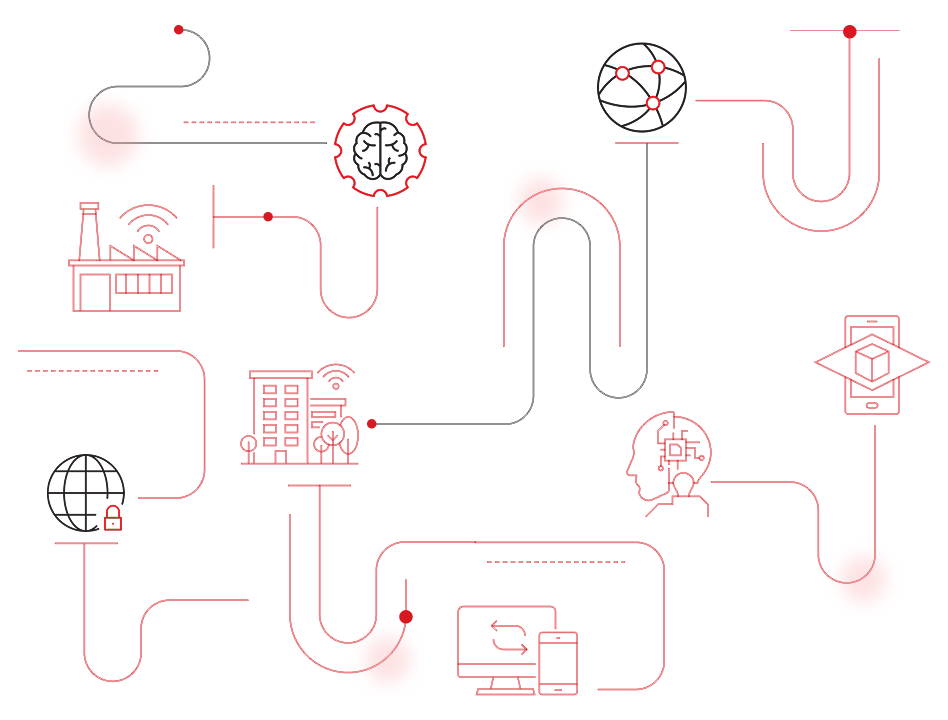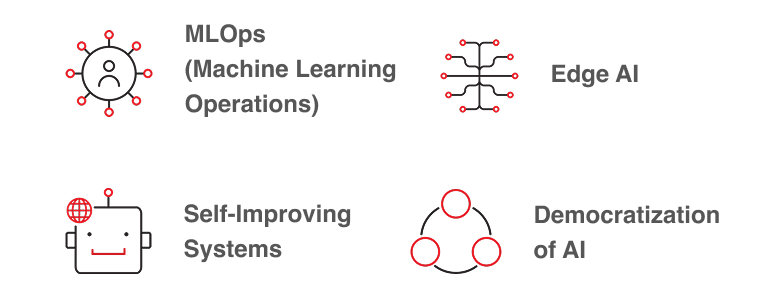
An AI Factory is a framework or environment designed to streamline the creation, deployment, and scaling of artificial intelligence (AI) systems. It emphasizes efficiency and automation, much like a traditional factory that produces physical goods.
Table of Contents
What does an AI Factory do?

An AI Factory streamlines and automates the end-to-end process of developing, deploying, and managing AI systems. It operates like a production line for AI, ensuring efficiency, scalability, and continuous improvement. Here are seven areas detailing what an AI Factory typically does:
1. Data Management
- Collects Data: Gathers raw data from various sources such as sensors.
- Processes Data: Cleans, organizes, and labels data to make it usable for ML.
- Stores and Secures Data: Ensures data is stored and complies with laws.
2. Model Development
- Trains AI Models: Uses machine learning algorithms to build models.
- Tests and Validates Models: Ensures AI models perform accurately.
- Optimize Models: Refines algorithms for better performance and efficiency.
3. Deployment
- Integrates AI into Applications: Deploys models into systems like apps or devices.
- Manages Infrastructure: Uses cloud or edge computing to scale AI systems.
4. Monitoring and Maintenance
- Tracks Performance: Monitors in real time to ensure reliability and effectiveness.
- Identifies Errors: Detects issues like bias, inaccuracies, or system failures.
- Retrains and Updates Models: Continuously improves models based on new data.
5. Automation and Scalability
- Automates Repetitive Tasks: Reduces manual workflows like data preprocessing.
- Scales Operations: Handles increasing amounts of data, users, or tasks.
6. Collaboration and Innovation
- Facilitates Teamwork: Provides tools for data scientists, engineers, and business.
- Drives Innovation: Enables rapid experimentation with models to solve problems.
7. Business Applications
- Delivers AI Solutions: Produces custom or pre-built models for specific industries.
- Supports AI-as-a-Service: Offers tools and platforms businesses can integrate.
In essence, an AI Factory automates and optimizes the lifecycle of AI systems, from data handling to deployment and continuous improvement, making AI development faster, more efficient, and scalable.
AI factories play a pivotal role in the modern data landscape by enabling organizations to harness the power of artificial intelligence (AI) efficiently, at scale, and with continuous improvement. They serve as an end-to-end ecosystem that transforms raw data into actionable insights, innovative solutions, and intelligent applications.
An AI Factory is a scalable, automated system that continuously develops trains, deploys, and improves artificial intelligence models using data pipelines, feedback loops, and infrastructure to optimize performance and value across applications.
An AI Factory is a conceptual and operational framework that enables organizations to systematically and efficiently build, deploy, and refine artificial intelligence (AI) systems at scale. It draws inspiration from traditional manufacturing, where raw materials are transformed into finished products through a series of standardized, repeatable processes.
In the case of an AI Factory, the “raw material” is data, and the “finished product” is a deployed AI model or service that delivers value to users or business operations.
Core Components of an AI Factory
Now that we’ve established what an AI Factory is and what one does, below are five of the core components of an AI Factory, some of which are vast, ever-innovating and growing.
Data Pipeline
The foundation of any AI Factory is a robust data pipeline. This includes data collection, ingestion, cleaning, labeling, and storage. The pipeline ensures that high-quality, relevant data is continuously fed into the system. Data can come from various sources: sensors, user interactions, business transactions, or third-party APIs.
Model Development
Once data is prepared, it moves into the model development phase. Here, data scientists and machine learning engineers use it to train AI models. This phase includes feature engineering, model selection, training, validation, and testing. Tools like AutoML can automate parts of this process, increase efficiency and reduce the need for manual intervention.
Model Deployment
After a model is trained and validated, it is deployed into production. This could mean integrating it into a mobile app, a web service, or an internal business tool. Deployment also involves setting up monitoring systems to track performance, latency, and user feedback.
Feedback Loop
A key feature of an AI Factory is the feedback loop. Deployed models generate new data through user interactions, which is then fed back into the system to retrain and improve the models. This loop enables continuous learning and adaptation, making the AI system more accurate and relevant over time.
Governance and Ethics
AI Factories must include mechanisms for ethical oversight, bias detection, and compliance with data privacy laws. Governance frameworks ensure that AI systems are transparent, explainable, and aligned with organizational values and societal norms.
Benefits of an AI Factory
Now that we’ve established what is an AI Factory, what one does, and some of the core components, let’s cover some of the benefits as well as examples in real life.
Scalability: AI Factories are designed to handle multiple projects simultaneously, allowing organizations to scale their AI initiatives efficiently.
Speed: Standardized processes and automation reduce the time it takes to go from data to deployment.
Consistency: By following repeatable workflows, AI Factories ensure consistent quality and performance across different models and applications.
Cost Efficiency: Automation and reuse of components (e.g., data pipelines, model templates) reduce development costs.
Continuous Improvement: The feedback loop enables ongoing refinement of models, leading to better outcomes over time.
Real-World Examples of an AI Factory
Amazon uses an AI Factory approach to power its recommendation engines, Alexa voice assistant, and logistics optimization. Netflix applies AI Factory principles to personalize content recommendations and optimize streaming quality. Tesla leverages an AI Factory to continuously improve its autonomous driving software using data collected from its fleet of vehicles.
How Does an AI Factory Work?
Now that we’ve established what an AI Factory is, what one does, and the core components, let’s discuss how an AI Factory works.
An AI Factory is a structured, automated system that transforms raw data into intelligent, deployable AI solutions. It begins with data collection, where information is gathered from various sources like sensors, user interactions, or databases. This data is then processed and cleaned to ensure quality and relevance.
Next, machine learning algorithms are applied in the model development phase. Engineers train models using the processed data, tuning them for accuracy and performance. These models are then validated and tested to ensure they meet performance standards.
Once ready, models are deployed into production environments—such as apps, websites, or internal tools—where they deliver real-time insights or automation. A feedback loop captures new data from user interactions, feeding it back into the system to retrain and improve models continuously.
Automation and orchestration are critical to the AI Factory. Automation handles repetitive tasks like data labeling, model training, and deployment, reducing human error and speeding up development. Orchestration ensures all components—data pipelines, model training, deployment, and monitoring—work seamlessly together.
This end-to-end system enables organizations to scale AI efficiently, adapt quickly to new data, and continuously improve performance.
Challenges in Building an AI Factory
Now that we’ve established what an AI Factory is, what one does, and the core components, how one works, let’s speak about some of the challenges. Although quite advantageous, an AI Factory can also have challenges when enterprises choose to build one. Five of these challenges are outlined below.

Data Quality and Availability
Poor data can lead to inaccurate models. Ensuring data is clean, labeled, and representative is a major challenge.
Integration Complexity
Integrating AI models into existing IT systems and workflows can be technically complex and resource-intensive.
Talent and Expertise
Building and maintaining an AI Factory requires a multidisciplinary team, including data engineers, ML researchers, software developers, and domain experts.
Ethical and Regulatory Compliance
Navigating the evolving landscape of AI regulations and ensuring ethical use of AI is a continuous challenge.
Infrastructure Costs
High-performance computing resources are often needed for training and deploying models, which can be expensive.
Key Technologies that Underpin AI Factories
An AI factory is an end-to-end system designed to automate and streamline the lifecycle of AI development, deployment, and management. Its purpose is to transform raw data into actionable insights or intelligent applications efficiently and at scale. By automating workflows such as data preprocessing, model training, deployment, and monitoring, AI factories accelerate time-to-value, ensure scalability, and enable continuous improvement of AI systems.
AI factories play a vital role by managing massive datasets, ensuring data quality, and complying with privacy regulations. They enable real-time analytics, power applications like fraud detection and predictive maintenance, and retrain models to adapt to changing environments. Furthermore, they democratize AI through accessible tools and platforms, allowing businesses across industries to innovate and leverage AI-driven insights.
Key technologies underpinning AI factories include high-performance computing (e.g., GPUs and TPUs), AI frameworks (e.g., TensorFlow, PyTorch), automation tools for data labeling and model orchestration, and cloud or edge computing for scalable deployment. AI factories also rely on advanced monitoring systems, DevOps tools like Kubernetes, and AI-specific infrastructure such as NVIDIA DGX or similar platforms. Together, these technologies create a robust ecosystem that drives efficiency, scalability, and innovation across industries.
Benefits of Implementing an AI Factory
Implementing an AI Factory offers significant benefits for organizations aiming to scale their AI initiatives. By standardizing and automating the AI development lifecycle—from data ingestion to model deployment—AI Factories dramatically increase efficiency and scalability, enabling teams to manage multiple AI projects simultaneously with fewer resources. This streamlined process also reduces time to market, allowing businesses to deploy AI applications faster and respond more quickly to changing market demands or customer needs.
Additionally, AI Factories enhance decision-making capabilities by continuously generating actionable insights from data. With automated feedback loops and real-time analytics, organizations can make smarter, data-driven decisions that improve operations, customer experiences, and strategic planning.
Moreover, AI Factories maintain AI compliance through integrated cybersecurity solutions that safeguard sensitive data throughout the development pipeline, ensuring regulatory adherence while protecting against data breaches and maintaining customer trust.
Industry Applications of AI Factories
AI Factories are transforming industries by enabling scalable, efficient, and intelligent solutions. In healthcare, they support predictive diagnostics, personalized treatment plans, and operational optimization by continuously learning from patient data. In finance, AI Factories power fraud detection, algorithmic trading, and customer service automation, improving accuracy and responsiveness.
Manufacturing benefits from predictive maintenance, quality control, and supply chain optimization, driven by real-time data and machine learning. Real-world examples include GE Healthcare, which uses AI Factories to streamline imaging diagnostics, and JPMorgan Chase, which automates risk analysis and compliance tasks.
Siemens applies AI Factory principles to enhance industrial automation and equipment reliability. These implementations demonstrate how AI Factories accelerate innovation and reduce operational costs.
Moreover, AI Factories are fueling emerging technologies like autonomous vehicles, smart cities, and robotics by providing the infrastructure needed for continuous learning and deployment. Their ability to integrate vast data sources and adapt models in real time makes them essential for industries embracing digital transformation.
Future of AI Factories
As AI becomes more embedded in business and society, AI Factories will evolve to become more autonomous, intelligent, and integrated. Four key trends include:

MLOps (Machine Learning Operations): The adoption of MLOps practices will further streamline the lifecycle of AI models, from development to deployment and monitoring.
Edge AI: AI Factories will increasingly support deployment to edge devices, enabling real-time decision-making closer to the data source.
Self-Improving Systems: With advances in reinforcement learning and online learning, AI Factories will produce systems that can adapt in real time without human intervention.
Democratization of AI: Low-code and no-code platforms will make AI Factory capabilities accessible to non-experts, expanding the reach of AI across industries.
Starting Your Journey with an AI Factory
Starting your journey with an AI Factory requires thoughtful planning and strategic alignment. Businesses should first assess their data readiness, ensuring they have access to high-quality, relevant, and well-governed data.
It's also crucial to define clear business objectives that AI can support, such as improving customer experience, optimizing operations, or driving innovation. Building the right cross-functional team—including data scientists, engineers, domain experts, and IT professionals—is essential for success.
When implementing an AI Factory, start small with pilot projects to validate workflows and demonstrate value before scaling. Adopt modular, reusable components for data pipelines, model training, and deployment to streamline development and reduce redundancy.
Embrace automation and orchestration tools to manage the AI lifecycle efficiently, from data ingestion to model monitoring. Integration with existing systems should be seamless, ensuring AI outputs are actionable and accessible across the organization.
Establishing strong governance frameworks for ethics, compliance, and model transparency is also key. Finally, foster a culture of continuous learning and iteration, using feedback loops to refine models and processes over time. By following these best practices, businesses can build a resilient, scalable AI Factory that delivers sustained value.
Frequently Asked Questions (FAQs)
What is meant by AI factory?
AI factories are virtual frameworks companies use to design, develop, and test AI systems.
What is the difference between an AI factory and a data center?
Data centers store and process data. AI factories use data to simulate and improve artificial intelligence (AI) systems.
Where are AI factories located?
AI factories are being built all over the world including in Europe, North America, and China.
What is an example of an AI factory?
AI factories have been built or used successfully by companies like Amazon, Uber, Netflix, Lockheed Martin, Tesla, Dell, and NVIDIA.
What is an AI server factory?
An AI server factory is an AI factory that’s used to develop, test, and optimize the design of AI servers.
What is the AI factory approach?
The AI factory approach is an ‘industrial’ model for designing, developing, testing, and optimizing AI systems.
How to build an AI factory?
AI factories are built by using machine learning technologies to analyze huge amounts of data and create a process for designing AI systems.
Who is leading the AI industry?
The AI industry is highly competitive and constantly evolving. Some of the current leading AI companies include NVIDIA, Microsoft, Apple, Alphabet, and Meta.
What company is building AI robots?
Some of the biggest robotics companies that use AI include Agility Robotics, Boston Dynamics, Figure AI, FANUC, ABB, and Vecna Robotics.
What company builds AI infrastructure?
Many companies are involved in building the GPUs, processors, chips, and other infrastructure needed for AI. Examples include NVIDIA, Intel, AMD, Microsoft, and AWS.